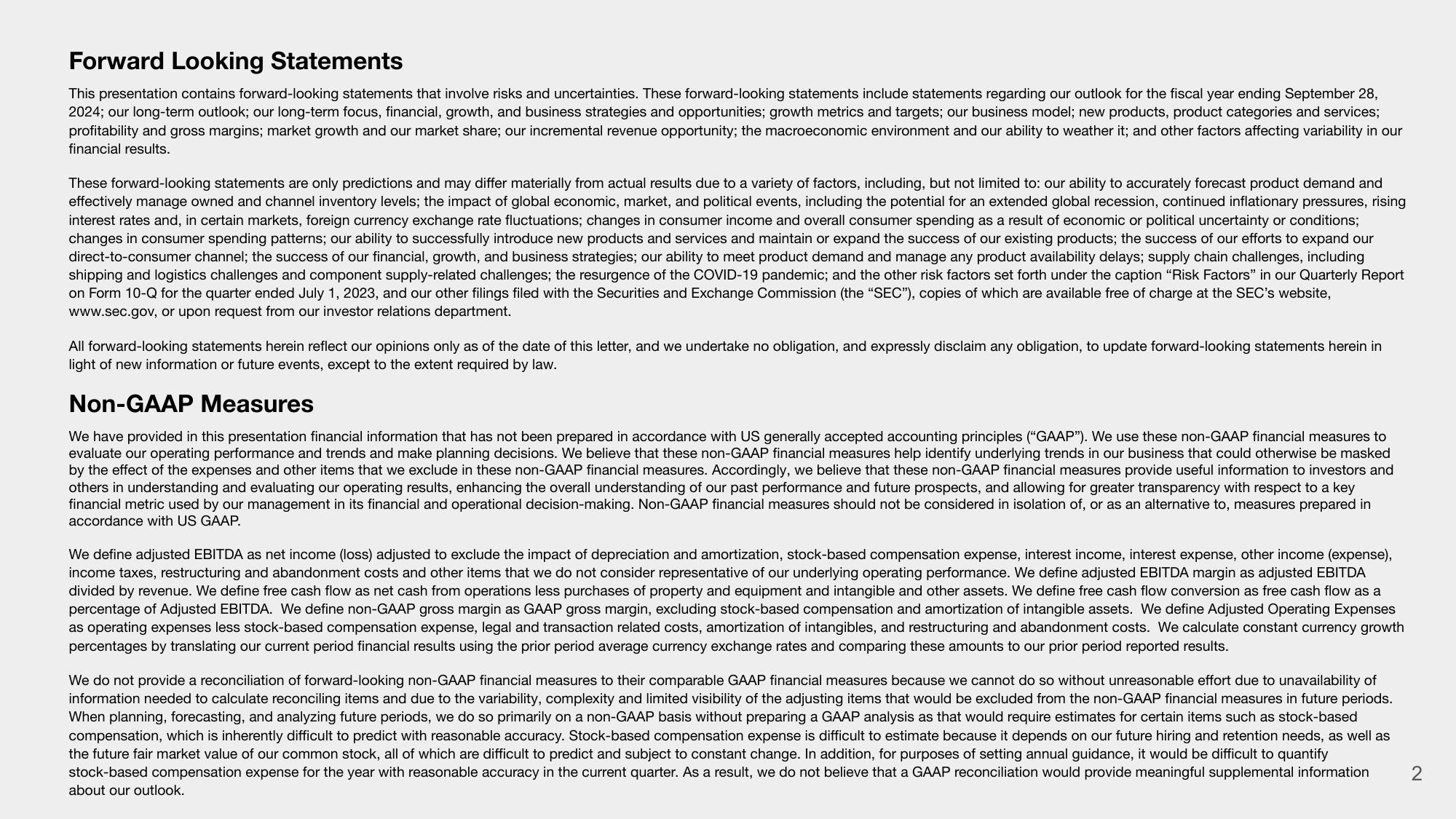Sonos Investor Presentation Deck
Forward Looking Statements
This presentation contains forward-looking statements that involve risks and uncertainties. These forward-looking statements include statements regarding our outlook for the fiscal year ending September 28,
2024; our long-term outlook; our long-term focus, financial, growth, and business strategies and opportunities; growth metrics and targets; our business model; new products, product categories and services;
profitability and gross margins; market growth and our market share; our incremental revenue opportunity; the macroeconomic environment and our ability to weather it; and other factors affecting variability in our
financial results.
These forward-looking statements are only predictions and may differ materially from actual results due to a variety of factors, including, but not limited to: our ability to accurately forecast product demand and
effectively manage owned and channel inventory levels; the impact of global economic, market, and political events, including the potential for an extended global recession, continued inflationary pressures, rising
interest rates and, in certain markets, foreign currency exchange rate fluctuations; changes in consumer income and overall consumer spending as a result of economic or political uncertainty or conditions;
changes in consumer spending patterns; our ability to successfully introduce new products and services and maintain or expand the success of our existing products; the success of our efforts to expand our
direct-to-consumer channel; the success of our financial, growth, and business strategies; our ability to meet product demand and manage any product availability delays; supply chain challenges, including
shipping and logistics challenges and component supply-related challenges; the resurgence of the COVID-19 pandemic; and the other risk factors set forth under the caption "Risk Factors" in our Quarterly Report
on Form 10-Q for the quarter ended July 1, 2023, and our other filings filed with the Securities and Exchange Commission (the "SEC"), copies of which are available free of charge at the SEC's website,
www.sec.gov, or upon request from our investor relations department.
All forward-looking statements herein reflect our opinions only as of the date of this letter, and we undertake no obligation, and expressly disclaim any obligation, to update forward-looking statements herein in
light of new information or future events, except to the extent required by law.
Non-GAAP Measures
We have provided in this presentation financial information that has not been prepared in accordance with US generally accepted accounting principles ("GAAP"). We use these non-GAAP financial measures to
evaluate our operating performance and trends and make planning decisions. We believe that these non-GAAP financial measures help identify underlying trends in our business that could otherwise be masked
by the effect of the expenses and other items that we exclude in these non-GAAP financial measures. Accordingly, we believe that these non-GAAP financial measures provide useful information to investors and
others in understanding and evaluating our operating results, enhancing the overall understanding of our past performance and future prospects, and allowing for greater transparency with respect to a key
financial metric used by our management in its financial and operational decision-making. Non-GAAP financial measures should not be considered in isolation of, or as an alternative to, measures prepared in
accordance with US GAAP.
We define adjusted EBITDA as net income (loss) adjusted to exclude the impact of depreciation and amortization, stock-based compensation expense, interest income, interest expense, other income (expense),
income taxes, restructuring and abandonment costs and other items that we do not consider representative of our underlying operating performance. We define adjusted EBITDA margin as adjusted EBITDA
divided by revenue. We define free cash flow as net cash from operations less purchases of property and equipment and intangible and other assets. We define free cash flow conversion as free cash flow as a
percentage of Adjusted EBITDA. We define non-GAAP gross margin as GAAP gross margin, excluding stock-based compensation and amortization of intangible assets. We define Adjusted Operating Expenses
as operating expenses less stock-based compensation expense, legal and transaction related costs, amortization of intangibles, and restructuring and abandonment costs. We calculate constant currency growth
percentages by translating our current period financial results using the prior period average currency exchange rates and comparing these amounts to our prior period reported results.
We do not provide a reconciliation of forward-looking non-GAAP financial measures to their comparable GAAP financial measures because we cannot do so without unreasonable effort due to unavailability of
information needed to calculate reconciling items and due to the variability, complexity and limited visibility of the adjusting items that would be excluded from the non-GAAP financial measures in future periods.
When planning, forecasting, and analyzing future periods, we do so primarily on a non-GAAP basis without preparing a GAAP analysis as that would require estimates for certain items such as stock-based
compensation, which is inherently difficult to predict with reasonable accuracy. Stock-based compensation expense is difficult to estimate because it depends on our future hiring and retention needs, as well as
the future fair market value of our common stock, all of which are difficult to predict and subject to constant change. In addition, for purposes of setting annual guidance, it would be difficult to quantify
stock-based compensation expense for the year with reasonable accuracy in the current quarter. As a result, we do not believe that a GAAP reconciliation would provide meaningful supplemental information
about our outlook.
2View entire presentation